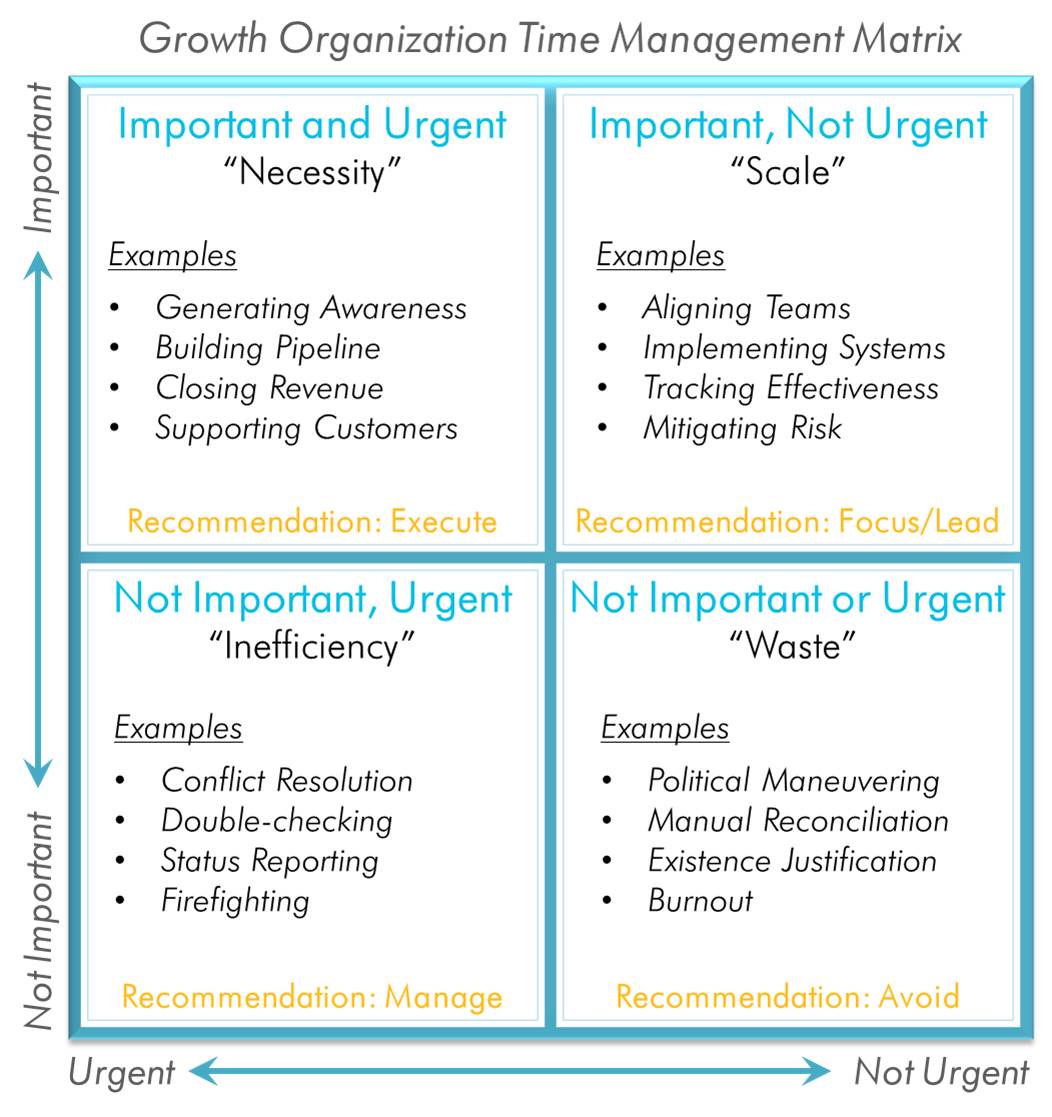Organizational Time Management
Deliberately allocating time to the right activities can make the difference for long term success.
Where should a growth organization spend its time?
Of all the resources startups have available to them, time is the most precious. In situations of rapid growth, just keeping up with the fundamentals can seem like an overwhelming task, but the long term success of any business depends on allocating time to a mix of tactical and strategic activities.
In his 1990 book “The Seven Habits of Highly Effective People”, Stephen Covey built a simple, intuitive framework to help individuals prioritize the allocation of their time against two axis: The Urgency of the activity in question, and the Importance of that activity. Using these two axis, Covey came up with four quadrants that categorize tasks:
|
Quadrant 1 Important and Urgent Tasks |
Quadrant 2 Important, but not Urgent Tasks |
|
Quadrant 3 Not Important, but Urgent Tasks |
Quadrant 4 Not Important, Not Urgent Tasks |
If we re-purpose this framework and apply it to an entire organization, we can take a macro view of where the organization as a whole is (and should be) spending its time.
Quadrant 1
Clearly it’s critical that organizations nail the “Important and Urgent” activities in order to be successful. If your company isn’t establishing market presence, generating demand, and creating revenue, nothing else matters. Most companies intuitively understand this, and a majority of time gets poured into this bucket. The key goal for organizations here is simply to execute well.
Quadrant 2
Spending time on initiatives that are “Important but not Urgent” is critical for long term success, and activities designed to help an organization scale reside here:
- Initiatives such as establishing and communicating a core set of organizational objectives ensures that teams are all pulling in the same direction.
- Implementing appropriate “right-sized” systems and processes ensures efficiency and accuracy in executing repeatable tasks.
- Cascading the top level organizational objectives to specific departmental/individual goals and metrics creates a sense of empowerment and accountability, as well as transparency to progress.
- Managing the various risks to the organization (business, market, operational, legal) ensures preparation for potential curveballs that could impede success.
Although most leaders understand the importance of allocating time to this area, organizations struggle to prioritize these activities. Because they are not “urgent”, they don’t get the focus that they deserve, and are buried under the constant avalanche of more pressing demands. To avoid this, there needs to be dedicated leadership and focus in this area, either internally or with outside assistance. Without it, an organization’s potential for growth can become limited.
Quadrant 3
The “Not Important but Urgent” activities are where undesirable outcomes start to materialize, and can be typically identified as “inefficiencies” within the organization:
- When top-level goals aren’t specifically articulated, functions operate independently and occasionally at odds with each other, which requires management intervention and conflict management to correct.
- The absence of adequate systems in place to manage processes and information means there is a constant need to retrain, communicate, and “double check” things to ensure appropriate accuracy.
- Without a system of metrics that clearly outline and track expected results, substitute mechanisms such as onerous status reporting, overly frequent “operational reviews”, or other sub-optimal mechanisms start to arise.
- Without awareness and adequate planning for risk, the organization is constantly fighting the resulting fires that erupt.
Because these activities are “urgent”, they get a significant amount of attention from the organization, yet it would be difficult to label any of them as truly important. While some amount of activity in this area is almost inevitable, the organization needs to manage these “symptoms” as efficiently as possible, while putting a focus in Quadrant 2 to stamp out the root causes.
Quadrant 4
Finally, the “Not Important, Not Urgent” quadrant is where organizations that consistently neglect long term planning and scalability find themselves. Symptoms such as excessive organizational politics, inordinate amounts of time spent on justifying spend or communicating organizational value, extensive manual reconciliation of activities or data, and overall burnout start to arise within the organization. At this point it takes a Herculean effort to get the organization back on a path that will lead to long term growth.
In Summary
It’s easy to see how slippery the slope is between these quadrants, as the sense of urgency can cloud the picture of what’s truly important. Only by dedicating focus on the “Important but not Urgent” activities of building organizational scale can companies ensure that they are insulating themselves from wasting their most precious resource – time.
Cross-functional initiatives often represent a high level of Why poor planning for your product launch will always come back If you don’t know where you’re going, any road will Scale is an important aspect of any growing business, but itLatest Posts
4 Steps to Keep Cross-Functional from Being Dysfunctional
Karma is a…well, you know
Strategic Planning
Right-Sizing Scale







3 Comments
Great, thanks for sharing this article post.Thanks Again. Really Great. Creger
Looking forward to reading more. Great blog post.Thanks Again. Fantastic.
“Thank You For Taking The Time To Share Your Expertise.”